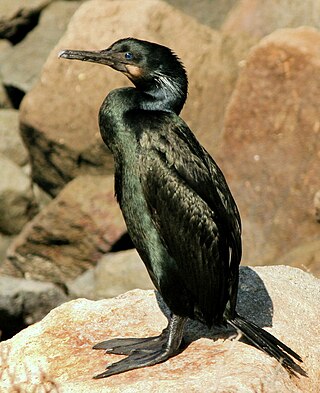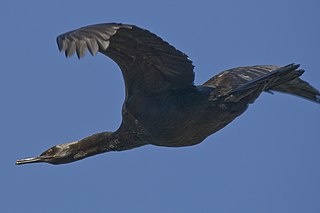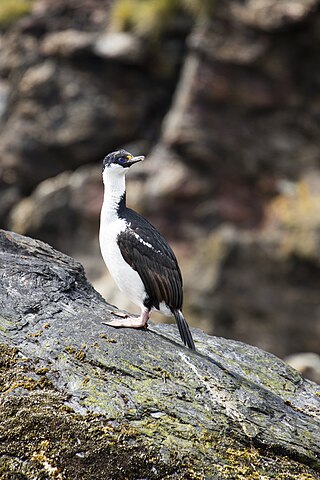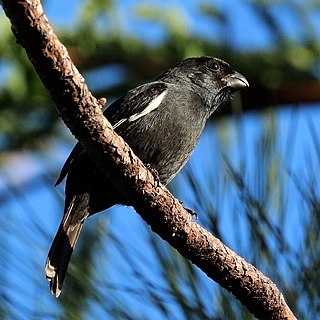
Phalacrocoracidae is a family of approximately 40 species of aquatic birds commonly known as cormorants and shags. Several different classifications of the family have been proposed, but in 2021 the IOU adopted a consensus taxonomy of seven genera. The great cormorant and the common shag are the only two species of the family commonly encountered in Britain and Ireland and "cormorant" and "shag" appellations have been later assigned to different species in the family somewhat haphazardly.

Brandt's cormorant is a strictly marine bird of the cormorant family of seabirds that inhabits the Pacific coast of North America. It ranges, in the summer, from Alaska to the Gulf of California, but the population north of Vancouver Island migrates south during the winter. Its specific name, penicillatus is Latin for a painter's brush, in reference to white plumes on its neck and back during the early breeding season. The common name honors the German naturalist Johann Friedrich von Brandt of the Academy of Sciences at St. Petersburg, who described the species from specimens collected on expeditions to the Pacific during the early 19th century.

Phalacrocorax is a genus of fish-eating birds in the cormorant family Phalacrocoracidae. Members of this genus are also known as the Old World cormorants.

The pelagic cormorant, also known as Baird's cormorant or violet-green cormorant, is a small member of the cormorant family Phalacrocoracidae. Analogous to other smallish cormorants, it is also called the pelagic shag occasionally. This seabird lives along the coasts of the northern Pacific; during winter it can also be found in the open ocean. Pelagic cormorants have relatively short wings due to their need for economical movement underwater, and consequently have the highest flight costs of any bird.

A kinglet is a small bird in the family Regulidae. Species in this family were formerly classified with the Old World warblers. "Regulidae" is derived from the Latin word regulus for "petty king" or prince, and refers to the coloured crowns of adult birds. This family has representatives in North America and Eurasia. There are six species in this family; one, the Madeira firecrest, Regulus madeirensis, was only recently split from common firecrest as a separate species. One species, the ruby-crowned kinglet, differs sufficiently in its voice and plumage to be afforded its own genus, Corthylio.

The gadfly petrels or Pterodroma are a genus of about 35 species of petrels, part of the seabird order Procellariiformes. The gadfly petrels are named for their speedy weaving flight, as if evading gadflies (horseflies). The flight action is also reflected in the name Pterodroma, from Ancient Greek pteron, "wing" and dromos, "runner".

The European shag or common shag is a species of cormorant. It is the only member of the monotypic genus Gulosus. It breeds around the rocky coasts of western and southern Europe, southwest Asia and north Africa, mainly wintering in its breeding range except for the northernmost birds. In Britain this seabird is usually referred to as simply the shag. The scientific genus name derives from the Latin for glutton. The species name aristotelis commemorates the Greek philosopher Aristotle.

The spectacled cormorant or Pallas's cormorant is an extinct marine bird of the cormorant family of seabirds that inhabited Bering Island and possibly other places in the Komandorski Islands and the nearby coast of Kamchatka in the far northeast of Russia. The modern distribution was shown to be a relic of a wider prehistoric distribution in 2018 when fossils of the species from 120,000 years ago were found in Japan. It is the largest species of cormorant known to have existed.

The neotropic cormorant or olivaceous cormorant is a medium-sized cormorant found throughout the American tropics and subtropics, from the middle Rio Grande and the Gulf and Californian coasts of the United States south through Mexico and Central America to southern South America, where it is called by the indigenous name of biguá. It also breeds on the Bahamas, Cuba and Trinidad. It can be found both at coasts and on inland waters. There are at least two subspecies: N. b. mexicanum from Nicaragua northwards and N. b. brasilianum further south. In Peru the neotropic cormorant is used by the Uru people for fishing.

Nannopterum is a genus of cormorant comprising three species. They are found throughout the Americas, hence the common name American cormorants.

The little black cormorant is a member of the cormorant family of seabirds. It is common in smaller rivers and lakes throughout most areas of Australia and northern New Zealand, where it is known as the little black shag. It is around sixty centimetres long, and is all black with blue-green eyes.

The red-faced cormorant, red-faced shag or violet shag, is a bird species of the family Phalacrocoracidae.

The rock shag, also known as the Magellanic cormorant, is a marine cormorant found around the southernmost coasts of South America. Its breeding range is from around Valdivia, Chile, south to Cape Horn and Tierra del Fuego, and north to Punta Tombo in Argentina. In winter it is seen further north, with individuals reaching as far as Santiago, Chile on the west coast and Uruguay on the east. The birds also breed around the coasts of the Falkland Islands.

The New Zealand king shag, also known as the rough-faced shag, king shag or kawau, is a rare bird endemic to New Zealand. Some taxonomic authorities, including the International Ornithologists' Union, place this species in the genus Leucocarbo. Others place it in the genus Phalacrocorax.

Leucocarbo is a genus of birds in the family Phalacrocoracidae with the members commonly known as blue-eyed shags. This is a group of closely related cormorant taxa. Many have a blue, purple or red ring around the eye ; other shared features are white underparts and pink feet.

Melopyrrha is a genus of passerine birds in the tanager family Thraupidae. It is made up of four extant species endemic to the Greater Antilles, along with 1 possibly extinct species from the island of Saint Kitts in the Lesser Antilles.

The white-browed gnatcatcher is a species of bird in the gnatcatcher family Polioptilidae. It is native to central and South America.

Microcarbo is a genus of fish-eating birds, known as cormorants, of the family Phalacrocoracidae. The genus was formerly subsumed within Phalacrocorax.

The order Suliformes is an order recognised by the International Ornithologist's Union. In regard to the recent evidence that the traditional Pelecaniformes is polyphyletic, it has been suggested that the group be divided to reflect the true evolutionary relationships, a 2017 study indicated that they are most closely related to Otidiformes (bustards) and Ciconiiformes (storks).

Symposiachrus is a genus of birds in the family Monarchidae. Most species are endemic to islands in Melanesia but the spectacled monarch is widely distributed and occurs in parts of Indonesia and western Australia. The genus was previously lumped together in the genus Monarcha.
























